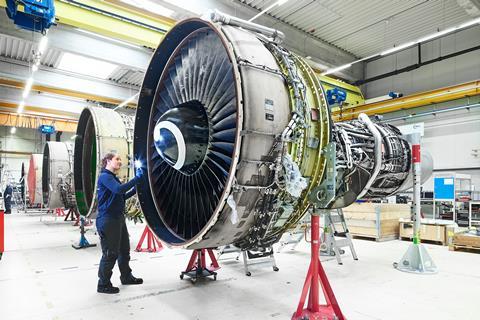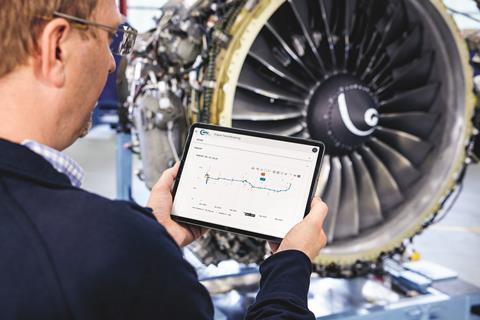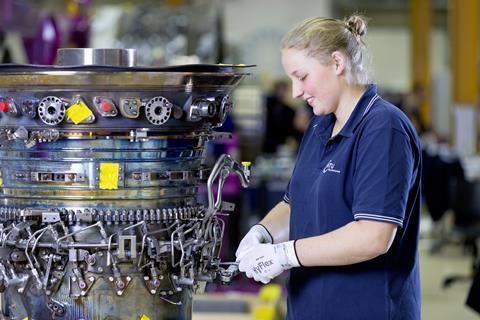The first and foremost realization by any worthy MRO service provider must be that no two aircraft engines are alike. And that one size never, ever fits even two, let alone, all. Airlines operate their fleets in a myriad different environments and conditions, which results in engine profiles that are almost as unique as finger prints.
MTU Maintenance has created its identity around bespoke solutions for each and every engine in need of MRO services. The central goal for the company’s engine experts is optimizing engine maintenance and the costs associated with its operations – be it a single engine or an entire engine fleet. The good news is that the latest assessment by IATA predicts consistent growth in airline revenues for 2024, up by 7.6% compared to last year’s numbers and totaling some $964 billion USD. However, as good an omen as that may be following the harsh pandemic years, the profitability of the airline industry has only marginally improved to 2.7 percent (up 0.1 percent year-to-year). That means that the entire commercial aviation industry is as sensitive as it has ever been to expenditures, of which maintenance eats up a sizeable portion each year.
The edge for engine MRO service providers for the foreseeable future will be how well they can optimize shop visits and maintenance scenarios, which rests on a combination of technical flexibility and transparency of the maintenance process. So the provider of today and tomorrow must include the ready use of digital tools, an array of services. Not to mention the necessary know-how to negotiate a dynamic aviation market as well as closer customer relationships than ever before.
Flexibility
Made up of nearly all of today’s most popular regional, narrow- and wide-body engines, MTU Maintenance’s portfolio is the largest of any globally operating MRO service provider. Because of that, the company must be nimble in its approach to maintenance solutions. As the industry has found out in recent years, changes can happen fast and the effects are long-lasting. There is a great impetus to offer novel ways to keep engines on-wing for as long as possible with minimal intervention before a truly necessary shop visit. That ability promises engine operators both operational stability and cost optimization, as they maneuver an uncertain business landscape.
MRO alternatives beyond traditional maintenance concepts, in that regard, have gained in popularity as they can keep engines flying while minimizing costs. MTU has seven locations within its global network that offer ON-SITEPlus services for aero engines, with crews ready to deploy at a moment’s notice from four continents.
One such on-site event towards the end of last year in Portugal showcases how novel customized solutions can make a huge difference in the operative success for both the service provider and the engine operator. A team of four ON-SITEPlus experts replaced the fan frame shroud on a CFM56-7B by standing the engine upright like a candle onto a rare piece of tooling – only two of which are in service in all of Europe – and moving the shroud carefully past the core and LPT modules. Of course, thanks to the CFM56’s modular design, it lends itself well to minimally invasive on-site workscopes, but it is also the most prolific and most technically dependable engines of all time, and airlines depend on its consistent reliability to deliver the required thrust at the lowest possible cost. MTU Maintenance’s more than 40 years of experience and technical infrastructure in turn ensures that continued operational reliability.
However, the flexibility does not end at the ability to dispatch mobile teams of engine experts. The company aims to offer as much flexibility within its aero engine services as possible, so that it can adapt to market conditions whenever necessary. Apart from the above mentioned on-site component, this also includes utilizing all available expertise – both engineering and market-related know-how – across the MRO’s global network and its individual capabilities, whether those are innovative workscoping and in-house repairs, or engine exchanges, leasing options and used serviceable parts supply.
If a customer is looking for a custom-made MRO program for their entire engine fleet, they can rely on MTUPlus intelligent solutions, which are split up into four distinct modular packages, depending on the age of the engine fleet and how the operator or owner wishes to use their assets. In any case, the central goals of such tailored solutions are to either optimize the value of the assets through green-time lease-outs, teardown options or consignment parts sale, in the case of VALUEPlus; or minimize the costs of operating young or mature engines with engine trend monitoring, predictive maintenance and optimized shop visit dates, or MRO alternatives (PERFORMPlus or SAVEPlus, respectively). With MOVEPlus, engine lessors have a portable MRO solution which mitigates the risks of transferring ownership while also increasing revenues. MTU Maintenance acts as a facilitator of engine transfers and supplies crucial know-how to assess the technical condition of the engines. This lowers the exposure for lessees and avoids unnecessary or redundant shop visits.
Each of those solutions is a sort of toolbox and not all elements will necessarily be used. Because operators are sometimes owners, MTU approaches each case individually, so there is a fair bit of mixing and matching of services to get the perfect constellation of provisions for a given customer.
Transparency
Transparency within the company’s service network comes twofold: one is the technical insight that the engineers, planners, mechanics and other experts derive from their daily work and share with the rest of MTU’s organization. The other is the service provider’s information sharing and interaction with its customer, which are key facets in the creation of precise maintenance strategies, especially in times of supply chains constraints and limited capacities throughout the industry.
Bespoke MRO services rely on a clear and stable mission or operational goal for a given engine or fleet, as defined by the engine operator, as well as on a symbiotic relationship with a service provider like MTU Maintenance and the customer. This means that ahead of any MRO work, all the necessary operational parameters have to be accounted for: age and make-up of the fleet, the environments in which it operates, maintenance history, expected changes to the fleet, etc. Having access to that kind of information and feeding it into its in-house developed engine fleet management software CORTEX allows MTU to generate precise, individual MRO scenarios for a customer, give them the ideal timing for a shop visit and optimize the maintenance costs over the lifetime of the engines. Aided by artificial intelligence, the software factors in operational parameters, cost structures, data from MTU’s engine trend monitoring and shop visit experience, as well as any existing data to calculate maintenance scenarios down to an engine’s life-limited parts. The scenarios also include material requirement predictions and potential engine leasing or exchange options. If the parameters change or new ones are introduced, CORTEX can recalculate a scenario momentarily.
MTU Maintenance also offers the most modern ways of communication to stay in touch with its engine experts. Accessible via any laptop or mobile device, myMTU is a central platform for customer interaction. It features a number of digital applications where customers can follow their engines. myETM and myESR have been set up as two key interfaces for informational exchange, delivering crucial data and status reports about an operator’s assets almost in real-time, be it in the air or in the shop!
Fed by MTU’s engine trend monitoring service provision, myETM gives access to the collected and processed in-flight data of an engine, including performance and operational parameters such as fuel flow, exhaust gas temperature, shaft speeds and other metrics. If there are abnormalities in the values, it sends an alert to a platform and MTU’s experts in engineering then analyze the deviations and make recommendations about a course of action, helping customers to avoid operational disruptions.
Borrowing from the term engine status report, myESR tracks a particular engine’s flow during a shop visit and gives up-to-date information how far along the engine has gotten at any given point in time. This includes what has already been done, what is still outstanding, what material will be required, associated cost estimates and readjustments, and other factors. In addition, customers can make requests and workscope decisions in collaboration with MTU’s personnel, as well as review proposed quotes. The app effectively gets rid of a deluge of emails and weekly documentations that were necessary in the past.
The use of digital tools and on-going development of additional ones as a way to introduce more transparency for MTU’s customers and in its own MRO operations has been of great advantage to the service provider because it can react much more nimbly to forces outside of its control.
No one could have predicted the tumult in aviation of the last few years and its on-going consequences in the market. During this time and since then, it has been of utmost importance for MTU to keep in very close contact with customers by all means available. Because optimized, bespoke services behave much like gears or a system of cogwheels. They are precisely tuned to each other and work amazingly well in unison. Interrupters, which often manifest from outside the sphere of influence can endanger an already optimally running mechanism.
In order to ensure minimal downtimes, maximum reliability and value at optimized cost for engine operators, MTU Maintenance uses the whole gamut of its engine expertise and infrastructure, which it has built over the last four decades, to provide an MRO service that is as innovative as it is collaborative











































